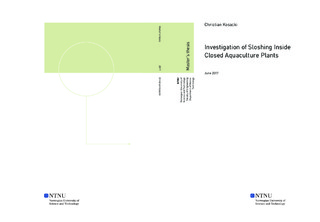| dc.description.abstract | This thesis concerns the sloshing effect inside closed fish farm plants exposed to external waves. To investigate the sloshing phenomenon, linear potential theory together with linear modal theory was implemented, and a model test at NTNU's Lilletanken using a floating circular cylinder with a free-surface on the inside was performed. The model scale was set to 1:81, representing a full scale enclosed fish farm plant with a diameter of 40 meters. Waves with three steepnesses H\lambda = 1/60, 1/45 and 1/30 with wave periods T = [3.6, 7.2] in full scales were used, and responses inside the bucket measured using wave probes, accelerometers and strain gauges at the anchoring lines.
The model test results show the largest measured sloshing amplitude occurs at $\omega = 1$ rad/s in full scale, corresponding to the coupled system frequency. The amplitude is measured to be 4-5 times larger than the incoming wave amplitude. The theoretical first sloshing mode is given at omega = 0.93 rad/s, which is approximately 10 % off the experimental sloshing amplitude. Due to linear theory, the Response Amplitude Operator (RAO) for the three steepnesses was expected to be similar, however the steepest wave gave a smaller RAO due to non-linearities like viscous damping of the model and overtopping of the outer collar of the model. The surge and pitch motions experiences a cancellation at each side of the natural sloshing frequency.
The comparison between the numerical sloshing amplitude and measured sloshing amplitude showed that the corresponding amplitudes over the frequency range did not match. The theoretical calculations resulted in a large top at the sloshing natural frequency followed by a smaller top at the experimentally found coupled frequency.
A sensitivity analysis of the prescribed motions used in the modal function solved numerically by the ODE45-function in MATLAB was performed. The results showed a great sensitivity of sloshing amplitude when varying the input parameters slightly, especially around the natural sloshing frequency of the sloshing. The new sloshing RAO with adjusted parameters fit the experimental sloshing RAO reasonably, except for the frequencies around the natural sloshing period.
The non-linear analysis showed presence of 2nd harmonic amplitudes at the sloshing RAOs at the natural sloshing frequency, which were also visible in the time-series plots of sloshing taken from the model test. Swirling was also detected at the shorter wave lengths with dominant 2nd harmonics at the side probe WP1 at the sloshing frequency.
This study shows that the sloshing is difficult to predict correctly and linear modal theory has shortcoming especially around the natural sloshing frequency even with prescribed motions. The sensitivity analysis revealed also high sensitivity to the input parameters. Therefore, great care must be taken when calculating numerical sloshing amplitudes. | |

